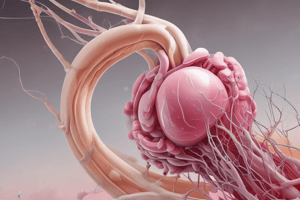Podcast
Questions and Answers
What is the function of the kidneys related to blood pressure?
What is the function of the kidneys related to blood pressure?
- Regulating blood glucose
- Secreting the enzyme renin (correct)
- Regulating blood pH
- Excreting wastes and foreign substances
Where are the kidneys positioned in relation to the peritoneum?
Where are the kidneys positioned in relation to the peritoneum?
- Attached to the peritoneum
- On the posterior abdominal wall behind the peritoneum (correct)
- Within the peritoneal cavity
- Anterior to the peritoneum
What is the function of erythropoietin released by the kidneys?
What is the function of erythropoietin released by the kidneys?
- Assisting in water conservation
- Regulating blood calcium levels
- Controlling blood osmolarity
- Stimulating red blood cell production (correct)
What is the position of the left kidney in relation to the level of T11?
What is the position of the left kidney in relation to the level of T11?
What is contained in the concave medial border of each kidney?
What is contained in the concave medial border of each kidney?
What is the position of the kidneys in relation to the peritoneum?
What is the position of the kidneys in relation to the peritoneum?
What is the function of calcitriol released by the kidneys?
What is the function of calcitriol released by the kidneys?
What is the axis of the kidneys?
What is the axis of the kidneys?
What is contained in the hilum of each kidney?
What is contained in the hilum of each kidney?
What is the relationship between the diaphragm and the right kidney?
What is the relationship between the diaphragm and the right kidney?
Flashcards are hidden until you start studying
Study Notes
Kidney Functions and Blood Pressure
- Kidneys help regulate blood pressure through the renin-angiotensin-aldosterone system, which adjusts blood volume and vascular resistance.
- Renin, an enzyme secreted by the kidneys, initiates a cascade that increases blood pressure when needed.
Position of the Kidneys
- Positioned retroperitoneally, meaning they lie behind the peritoneum, outside of the abdominal cavity.
- Generally, the left kidney is situated slightly higher than the right, often at the level of T11, while the right kidney is at the level of T12 to L3.
Hormonal Functions
- Erythropoietin, produced by the kidneys, stimulates red blood cell production in the bone marrow in response to low oxygen levels.
- Calcitriol, the active form of vitamin D, promotes calcium absorption in the intestines, essential for bone health and maintaining calcium levels.
Structural Orientation
- The kidneys have a hilum on their concave medial border containing blood vessels, nerves, and lymphatics entering and exiting the organ.
- The axis of the kidneys refers to the orientation of the kidneys, which are positioned obliquely in the body, with the upper poles located more medially than the lower poles.
Anatomical Relations
- The right kidney's position is influenced by the diaphragm, which sits above it, potentially causing the right kidney to be slightly more inferior due to the liver's presence above it.
Studying That Suits You
Use AI to generate personalized quizzes and flashcards to suit your learning preferences.




